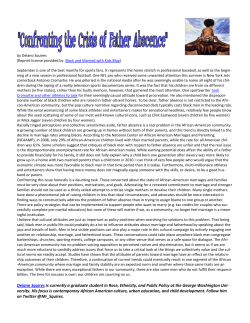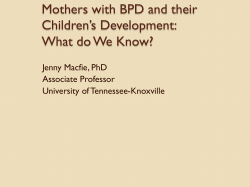
U.S. CHILDREN IN SINGLE-MOTHER FAMILIES Data Brief
Data Brief MAY 2010 BY MARK MATHER, PH.D. Seven in 10 children living with a single mother are poor or low income, compared with less than a third of children living in other types of families. 24% of the 75 million children under age 18 lives in a single-mother family. Ensuring that single mothers have access to education, job training, quality child care, and equal wages are some of the ways to ensure children’s successful transitions to adulthood. U.S. CHILDREN IN SINGLE-MOTHER FAMILIES In the United States, the number of children in single-mother families* has risen dramatically over the past four decades, causing considerable concern among policymakers and the public. Researchers have identified the rise in single-parent families (especially mother-child families) as a major factor driving the long-term increase in child poverty in the United States. The effects of growing up in singleparent households have been shown to go beyond economics, increasing the risk of children dropping out of school, disconnecting from the labor force, and becoming teen parents. Although many children growing up in single-parent families succeed, others will face significant challenges in making the transition to adulthood. Children in lower-income,† singleparent families face the most significant barriers to success in school and the work force. The purpose of this brief is to summarize the current social and economic situation of children in single-mother families in the United States, and to compare the characteristics of single-mother families across different racial and ethnic groups. Despite the volumes of research available on this topic, there are still many misconceptions about single-mother families based on outdated or anecdotal information. Here are some of the key facts based on the latest data from the U.S. Census Bureau’s Current Population Survey (CPS). During the 1970s and 1980s there was a rapid increase in single-mother families, leading to numerous national and state policy initiatives aimed at strengthening marriage. In fact, one of the primary goals of welfare reform legislation was to “encourage the formation and maintenance of two-parent families” as a means of improving outcomes for kids. Despite these efforts, the share of single-mother families has been remarkably stable since the mid1990s and has remained at record high levels. Today, nearly one-fourth (24 percent) of the 75 million children under age 18 lives in a single-mother family (see Table 1, page 2). Of the 18.1 million children in single-mother families, 9.2 million are under 9 years of age. Although single-father families have increased in recent years, single-mother families still account for the overwhelming majority of children living in single-parent homes. However, the likelihood of having a single mother varies widely across different racial/ethnic groups. About one-sixth (16 percent) of white children live in single-mother families, compared with one-fourth (27 percent) of Latino children and one-half (52 percent) of African American children. During the past 30 years, there has been a steady increase in the share of single mothers who have never been married, and a drop in single motherhood resulting from divorce or separation. Still, in 2009, more than half of all single mothers (53 percent) have been previously married. Among white single mothers, two-thirds (66 percent) have been previously married, compared with nearly half (48 percent) of Latino single mothers and a third (34 percent) of African American single mothers. These CPS-based figures are cause for concern, but also overstate the overall prevalence of singlemother families. A growing share of children—7 percent in 2008—live in households headed by cohabiting domestic partners. Thus, there is a growing number of children classified as living in “singlemother families” who are actually residing with two parents. Although children in cohabiting-partner families can benefit from the economic contributions of two potential caregivers, these unions tend to be less stable and have fewer economic resources compared with married couples. *In this brief, single-mother families are defined as families headed by a female with no spouse present—living with one or more own, never-married children under age 18. In 2009, there were about 18.1 million children in the United States living in single-mother families. Single-mother families are a subset of femaleheaded families, which include mother-child families as well as children in the care of grandparents or other relatives. In 2009, there were 19.6 million U.S. children residing in female-headed families. † Families are defined as “poor” if their total income is less than 100 percent of the official poverty threshold (about $22,000 for a family of four) and “low income” if income is less than 200 percent of the poverty threshold (about $44,000 for a family of four). Estimates of poverty and low-income status are based on income received during the previous calendar year. TABLE 1 Living Arrangements of U.S. Children by Age Group, 2009 ALL CHILDREN CHILDREN AGES 0-8 (IN THOUSANDS) PERCENT (IN THOUSANDS) PERCENT 100.0 All children 74,510 100.0 37,490 In married-couple families 49,560 66.5 25,192 67.2 In single-parent families 21,702 29.1 11,081 29.6 Single-mother families 18,090 24.3 9,229 24.6 3,612 4.8 1,852 4.9 Single-father families In other female-headed families 1,556 2.1 547 1.5 Other living arrangements 1,691 2.3 670 1.8 Source: PRB analysis of the U.S. Census Bureau’s 2009 Current Population Survey. Poverty in Single-Mother Families Most single-mother families have limited financial resources available to cover children’s education, child care, and health care costs. Seven in 10 children living with a single mother are poor or low income, compared to less than a third (32 percent) of children living in other types of families. While part of the problem is fewer potential earners in female-headed families, many of these families are also at a disadvantage because of problems collecting child support payments from absent fathers. In 2007, only 31 percent of female-headed families with children reported receiving child support payments during the previous year. It is especially difficult for young, never-married mothers to collect child support because many of the fathers in this situation have very low wages. For younger children ages 0 to 8, results are even more striking. In 2008, over three-quarters (77 percent) of young children FIGURE 1 Low-Income Children Living in Single-Mother Families, by Race/Ethnicity, 2009 Percent 66 51 47 42 35 35 21 All Children White* African American American* Indian/ Alaska Native* Asian/ Pacific Islander* Other Race* Latino *Non-Hispanic. Source: PRB analysis of the U.S. Census Bureau’s 2009 Current Population Survey. 2 www.prb.org in single-mother families were poor or low income. At the state level, 81 percent of young children in single-mother families in Michigan were low income, compared with 84 percent in New Mexico and 87 percent in Mississippi. Single mothers with young children tend to have less education and work experience, resulting in lower wages among those women. Given their low family incomes, children with single mothers make up the majority (54 percent) of poor children in the United States and a disproportionate share of children in low-income families (42 percent). However, in the context of high unemployment rates and low wages, there is a growing number of married-couple families with insufficient income to lift themselves out of poverty. There are also important differences by race/ethnicity (see Figure 1). While just over a third (35 percent) of low-income white children live in single-mother families, two-thirds (66 percent) of low-income African American children live in such families. The share of low-income Asian American children in single-mother families is only 21 percent, about half the national average. Overall, white children account for the largest share of children living in single-mother families (38 percent), followed by African Americans (31 percent) and Latinos (25 percent). However, among low-income children in single-mother families, 34 percent are African American, 31 percent are white, and 28 percent are Latino (see Figure 2, page 3). This mosaic of single-mother families with different racial, ethnic, and national backgrounds— some parents divorced or separated, others never married or cohabiting—creates a challenge for policymakers, who need to recognize the different paths to single motherhood and the unique needs of children in different types of families. The rapid increase in Latinos and Asians in the United States is changing the racial/ethnic composition of the U.S. population and could affect future trends in single-parent families. The children of immigrants, whose parents are mostly from Latin U.S. CHILDREN IN SINGLE-MOTHER FAMILIES FIGURE 2 FIGURE 3 Distribution of Children by Family Type and Income, 2009 Selected Characteristics of Single Mothers Ages 18-64, by Low-Income Status, 2009 All Children Children in SingleMother Families Children in LowIncome SingleMother Families White* Latino 56 22 38 31 25 14 31 28 34 African American* Other Race* 8 7 6 *Non-Hispanic. Other race groups include Asian Americans, American Indians, and those who selected more than one race. Source: PRB analysis of the U.S. Census Bureau’s 2009 Current Population Survey. Percent Low Wages, Few Benefits Three-fourths of all single mothers are in the labor force, and single mothers have slightly higher labor force participation rates than women in married-couple families. However, single mothers are more than twice as likely to be unemployed (13 percent), compared with mothers in married-couple families (5 percent); and the majority of employed single mothers—62 percent—are working in lower-wage retail, service, or administrative jobs that offer few benefits. Despite high rates of labor force participation, more than one-fourth (27 percent) of single mothers do not have health insurance. Among those who are insured, two-fifths are covered by public insurance programs. In contrast, over 90 percent of insured mothers in married-couple families have private health insurance coverage. Coverage rates are important because children without continuous health insurance coverage are more likely to have unmet health needs and less likely to receive preventive care. What characteristics of low-income single mothers distinguish them from single mothers with more financial resources? Low-income single mothers are more likely to be young, never married, less educated, and unemployed. Over half of lowincome single mothers (52 percent) are under age 34, compared with 38 percent of higher-income single mothers (see Figure 3). Three-fifths (61 percent) of low-income single mothers have not attended college, compared with two-fifths of single mothers in higher-income families. Low-income single mothers are also more than twice as likely to be unemployed or not in the labor force (43 percent) compared to their higher-income counterparts (16 percent). And among those who are employed, low-income U.S. CHILDREN IN SINGLE-MOTHER FAMILIES 43 40 38 30 16 Never Married Ages 18-34 Below 200% Poverty America and Asia, are more likely to live in married-couple families compared with children in U.S.-born families. Therefore, as the number of Latinos and Asians increase relative to other racial/ethnic groups, the share of single-mother families could stabilize or decrease over time. 61 56 52 High School Degree or Less Unemployed or Not in Labor Force 200% Poverty or Higher Source: PRB analysis of the U.S. Census Bureau’s 2009 Current Population Survey. single mothers are much more likely to work in the service sector (41 percent) compared to single mothers in higher-income families (17 percent). This combination of maternal characteristics puts children in lower-income single-mother families at high risk of negative outcomes compared to their counterparts in higher-income families. A large number of lower-income single mothers have become “disconnected” from education and work. Given the current state of the job market, these single mothers are at high risk of remaining jobless and poor, with little hope of pulling themselves out of poverty. Redefining Single-Mother Families Single mothers face serious economic challenges, which may explain the growing number of single mothers living with cohabiting partners, parents, or other relatives. Increasingly, singlemother families seem to be adopting alternative and flexible living arrangements “as an adaptive response to economic hardship.” These new living arrangements are redefining what it means to live in a single-mother family. Changes in family structure also raise questions about how we should measure income and poverty in single-mother families. For example, there is growing recognition that the official poverty measure is inappropriate because it does not account for income contributions from unmarried partners and other (unrelated) household members. Federal data sources are often inadequate for measuring children’s complex living arrangements. We have good information about children living with their biological parents but less is known about those living with unmarried parents, cohabiting domestic partners, grandparents, or other relatives. It is important to note that because Census Bureau surveys are household-based, they exclude contextual factors such as effects of neighborhood conditions and schools, which can have www.prb.org 3 important effects on children’s day-to-day lives as well as their longterm education success and economic well-being. In addition, data on children in single-mother families are collected nationally but are often insufficient for targeting programs and services for children in local communities. References Many single mothers have been resilient in the context of welfare reform and more recently, during the severe economic recession. But single mothers are disproportionately unemployed, or working in low-wage jobs with few benefits, and children growing up in single-mother families remain among the most vulnerable children in the country. While neighborhood characteristics, schools, and peer networks play important roles in children’s development, parents continue to provide the major source of social and economic support in children’s lives. Ensuring that single mothers have access to education, job training, quality child care, and equal wages are some of the ways to ensure children’s successful transitions to adulthood. Acknowledgments Mark Mather is associate vice president of Domestic Programs at the Population Reference Bureau. The author thanks staff at the Communications Consortium Media Center, the W.K. Kellogg Foundation, and the Population Reference Bureau for reviewing this publication. Financial support was provided by the W.K. Kellogg Foundation. 1 John Iceland, “Why Poverty Remains High: The Role of Income Growth, Economic Inequality, and Changes in Family Structure, 1949-1999,” Demography 40, no. 3 (2003): 499-519. 2 Sarah McLanahan and Gary Sandefur, Growing Up With a Single Parent: What Hurts, What Helps (Cambridge, MA: Harvard University Press, 1994). 3 U.S. Department of Health and Human Services, Administration for Children and Families, Office of Planning, Research, and Evaluation, “VII. Formation and Maintenance of Two-Parent Families,” accessed at www.acf.hhs.gov/programs/ ofa/data-reports/annualreport6/chapter07/chap07.htm, on Nov. 3, 2009. 4 Lynne M. Casper and Suzanne M. Bianchi, Continuity and Change in the American Family (Thousand Oaks, CA: Sage Publications, 2001): 100-101. 5 Annie E. Casey Foundation, KIDS COUNT Data Center, accessed at http:// datacenter.kidscount.org/data/acrossstates/Default.aspx, on Nov. 3, 2009. 6 Wendy D. Manning and Daniel T. Lichter, “Parental Cohabitation and Children’s Economic Well-Being,” Journal of Marriage and Family 58, no. 4 (1996): 9981010; and Wendy D. Manning, Pamela J. Smock, and Debarun Majumdar, “The Relative Stability of Cohabiting and Marital Unions for Children,” Population Research and Policy Review 23, no. 2 (2004): 135-59. 7 Annie E. Casey Foundation, KIDS COUNT Data Center. 8 Anne C. Case, I-Fen Lin, and Sara S. McLanahan, “Explaining Trends in Child Support,” Demography 40, no. 3 (2003): 171-89. 9 Population Reference Bureau, analysis of data from the U.S. Census Bureau’s 2008 American Community Survey Public Use Microdata Sample. These estimates may not be comparable to those based on CPS data because of different methods of data collection. 10 U.S. Census Bureau, “Table 4. Poverty Status of Families, by Type of Family, Presence of Related Children, Race, and Hispanic Origin: 1959 to 2008,” accessed at www.census.gov/hhes/www/poverty/histpov/hstpov4.xls, on April 21, 2010. 11 Mark Mather, “Children in Immigrant Families Chart New Path,” PRB Reports on America (Washington, DC: Population Reference Bureau, 2009). 12 Lynn M. Olson, Suk-fong S. Tang, and Paul W. Newacheck, “Children in the United States With Discontinuous Health Insurance Coverage,” The New England Journal of Medicine 353, no. 4 (2005): table 4, accessed at http://content.nejm. org/cgi/content/full/353/4/382/T4, on Sept. 25, 2009. 13 Rebecca Blank, “How Can We Reduce the Rising Number of American Families Living in Poverty?” accessed at www.brookings.edu/testimony/2008/0925_ poverty_reduction_blank.aspx, on Nov. 3, 2009. 14 Daniel T. Lichter and Zhenchao Qian, “Marriage and Family in a Multiracial Society,” The American People (New York: Russell Sage Foundation and Population Reference Bureau, 2004): 19-20. 15 Rebecca Blank, “How to Improve Poverty Measurement in the United States,” accessed at www.brookings.edu/papers/2008/06_poverty_blank.aspx, on Nov. 3, 2009. 16 National Research Council and Institute of Medicine, From Neurons to Neighborhoods: The Science of Early Childhood Development, ed. Jack P. Shonkoff and Deborah A. Phillips (Washington, DC: National Academies Press, 2000). 17 Casper and Bianchi, Continuity and Change in the American Family. POPULATION REFERENCE BUREAU The Population Reference Bureau INFORMS people around the world about population, health, and the environment, and EMPOWERS them to use that information to ADVANCE the well-being of current and future generations. www.prb.org POPULATION REFERENCE BUREAU 1875 Connecticut Ave., NW Suite 520 Washington, DC 20009 USA 202 483 1100 PHONE 202 328 3937 FAX popref@prb.org E-MAIL U.S. CHILDREN IN SINGLE-MOTHER FAMILIES
© Copyright 2025










